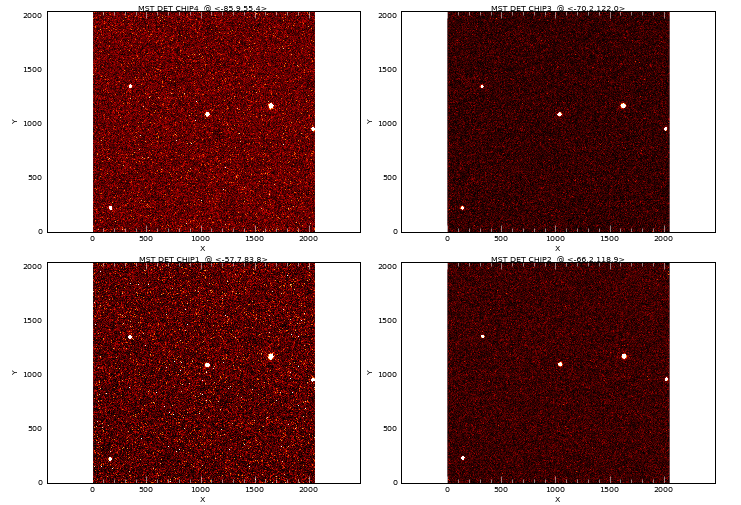 mirror sites:
PL (internal link)
HQ
[?]
mirror sites:
PL (internal link)
HQ
[?]
Quality Control and
Data Processing
|
HAWKI: System efficiency
The zeropoint trending is based on photometric standard star calibration data in J, H, Ks, & Y broad band filters. The data are obtained every photometric or clear night during which HAWK-I SCIENCE observations are executed. Each standard star dedicated observation consists of 4 star images where the target is placed at the center of each detector sequentially. This is repeated for all filters. The computed zeropoints, corrected for atmospheric extinction, are monitored for each detector separately. As of 2015-10-01 new HAWKI pipeline, prepared by CASU (v.2.+), is used. The zeropoints derived by this pipeline (recipe hawki_standard_process) differ significantly (by about 2 mag) from the previous values. See further for more information.
 Zeropoint
Zeropoint
Zeropoints are obtained to monitor the instrument performance. At the observatory, they are also used to make a rough assessment of the quality of the night. If a good photometry is required by a science program, special calibrations need to be included in the proposal. The HAWK-I detectors show different sensitivity. The Chip3 and Chip1 are most sensitive (highest zeropoints). Long term monitoring shows that the zeropoints decrease between subsequent M1 (main telescope mirror) recoating events witha rough rate of 0.02 mag per year.
The extinction corrected photometric zeropoints (at airmass X=0), derived from photometric standard star calibration frames observed in different filters are trended. On 2016-11-19 new, CASU pipeline was adopted, which uses revised method for calculating zeropoints. It takes into accout DET.NDIT in the total observing time (DET.DITxDET.NDIT) rather than DET.DIT as was done by the previous pipeline. To be able to compare vales from before and after, the CASU zeropoints are corrected by "+ 2.5 * log10(NDIT)". Only data taken with DET.NDIT=5 are plotted
The zeropints are not scored.
The HAWK-I pipeline computes zeropoints using the
UKIRT and Persson catalogues. For many stars the
catalog Y filter entries are missing, thus the
zeropoints can not be measured. As of 2015-10-01, new, CASU written pipeline (v.2.+) is adopted. The zeropoints are calculated with a different formula: zmag = mag + 2.5*log10(flux/CASUEXPT) + APCOR3 + DRS.EXTINCT where CASUEXPT [s] is consistent with EXPTIME=DIT*NDIT, APCOR3 [mag] is the pipeline estimated aperture correction (header keyword APCOR3) and the DRS.EXTINCT [mag] is assumed extintion (header keyword DRS.EXTINCT). The old pipeline (recipe hawki_cal_zpoint) was assuming EXPTIME=DET.DIT as the integration time returned by the instrument is always averaged over DET.NDIT. Thus, to relate measurements by these two pipelines the CASU values need to be corrected by "+ 2.5 * log10(NDIT)". To avoid variations among monitored zeropoints, only data taken with DET.NDIT=5 are plotted in the corresponding Health Check plot. |
||||||||||||||||||||||||||||||||||||||||||||||||||||||||||||||||||||||||||||||||||||||||||||||||||||||||||||||||||||||||||||||||||||||||||||||||||||||||||||||||||||||||||||||||||||||||||||||||||||||||||||||||||||||||||||||||||||||||||||||||||||||||||||||||||||||||||||||||||||||||||||||||
| |
|||||||||||||||||||||||||||||||||||||||||||||||||||||||||||||||||||||||||||||||||||||||||||||||||||||||||||||||||||||||||||||||||||||||||||||||||||||||||||||||||||||||||||||||||||||||||||||||||||||||||||||||||||||||||||||||||||||||||||||||||||||||||||||||||||||||||||||||||||||||||||||||||
 |
|
||||||||||||||||||||||||||||||||||||||||||||||||||||||||||||||||||||||||||||||||||||||||||||||||||||||||||||||||||||||||||||||||||||||||||||||||||||||||||||||||||||||||||||||||||||||||||||||||||||||||||||||||||||||||||||||||||||||||||||||||||||||||||||||||||||||||||||||||||||||||||||||||
